I. Biography
Born: June 1st, 1955.
Occupation: Artist in Sculpture innately and professionally.
- I started my profession at the age of 8 with the encouragement of my parents and my art teacher.
- I entered my tertiary studies in General Mechanics and Industrial drawings which helped my artistic nature to mature.
I discovered the depth of my love for this profession and thus started my road as an artist and sculptor.
-When the war started in 1976, I went to Brazil, taking with me some drawings of Lebanon and the countryside. I caught the attention of my Lebanese patriots, so I continued to study the types of stones in Sao Paulo. I sculptured the rocks.
I discovered there into things that represent Lebanon, such as the Cedars and other folkloric items.
- I put the things I created on exhibition in a Lebanese club in Sao Paulo in 1978. I was greatly encouraged by the Lebanese people there to the extent that everything sold out.
- I also participated in many exhibitions both personal and with other artists also which included sculpturing and mosaics.
- The joint exhibitions for Sculpturing and Mosaics in Lebanon were:
- 1979 - Mackhoul Street
- 1983 and 1984 - Ghazir High School
- 1994, 95 & 96 - “The stairs of Artists” in Gemayzeh
- 1997 - Beit Mery
- 2000 - Held by the Education Minister in Downtown Beirut
- 2001 & 2002 - Tourism Ministry Hall - Al Hamra
- 2003, 2004 & 2005 - Held by the American embassy in Rotana - Jevinor Center
- Personal Exhibitions:
- 2003 - In association with Lions International in UNESCO hall under the name “Nature in the mirror of an artist”.
- I also have a full-time exhibition in Konnabet - Broummana
- I also worked with the artist Ghaleb Aoun in Saida on murals for renovating the city
- Other Works:
- 1990 - An altar for the Notre Dame church in Ghazir
- 1991 – An altar for the Notre Dame church in Zouk Mikhael
- Many other sculptures and mosaics in many other towns and churches.
My latest works focused on the Lebanese traditions and Phoenician ship scrolls and vessels with fish fossils that I put to enhance their beauty.
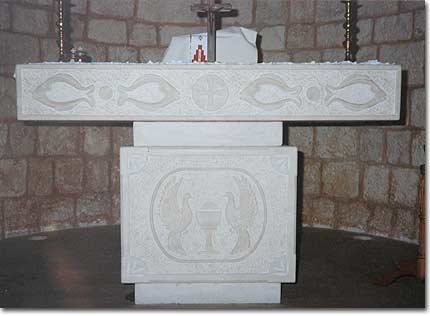
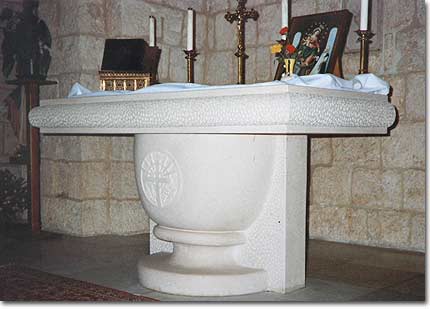
Altars in Lebanese churches
All these things are in an ongoing exhibition for tourists in Jbeil-Byblos.
- Awards:
- A medal from the Tourism Industry
- Letter of appreciation from the American Embassy for the Rotana exhibition.
The Birth of Rocks by Tony El-Hachem:
Our country has been rich in rocks since the beginning of time. Our volcanoes spewed lava and after cooling down formed many coloured stones throughout the years. It was rescued from nothing to existence differing in types and colours as we humans differ from each other.
Stones have natural colours like beige, white, yellow, black and red as humans and nature do. Marble and Granite spoke in the many different languages of the earth, reflecting in the mirror of the Creator.
Stones have entered churches for holiness and sacred designs for burial sites, headstones and fortresses, and is still a witness to the past and present and will always be ageless, always staying young, preserving it’s beauty, even when hidden under the soil of the earth.
I have taken from your dust a balm for my soul and my wounds.
After the birth of the rock, I form you with my chisel. You remain an inspiration to me and represent me as I am. You refuse forgery, you are faithful and eternal as the fingerprints always unchangeable. I kiss you and approve of my achievements since you will remain even after my son and my grandchildren, to speak of me, you are my ambassador to all countries, being true to my will even after I die.
My view as an Artist in this day and age:
Where is true art in these days of computer programming? They sculpt statues and dye it artificially by the art of computers. It stands as a barrier between a faithful artist and true emotions who can sign is name on his creations, but a computer can’t sign it’ own art and is not acceptable in museums.
Art has become only for commercial gain and doesn’t represent our rich heritage to be a witness to future generations of our artistic past.
The preferred language between the nations was hieroglyphics, and cavemen used to draw murals in caves about symbols, but for these, they would not have been remembered.
The Art of Mosaics started in Phoenician and Roman times and was added to the Byzantine church.
Nature is a mobile pharmacy, with its green veil, it lives in desolate houses, plants a tree in it’s midst after it’s sandy roof has disappeared, it replenishes it’s stolen rights with the wind as it’s source.
What is natural for us? We cut trees and burn the forests, but it has overcome and it has returned it’s greenness after man frowned on its existence. But nature soldiers on in its beauty because God in an artist and through nature we can see his prints.
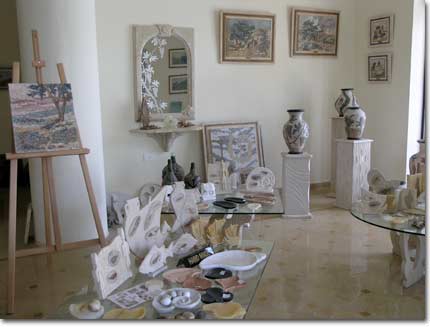
Corner of the studio of the artist
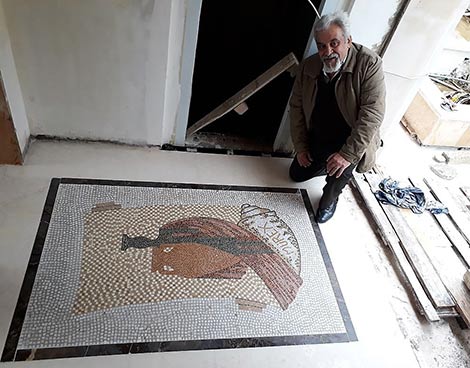
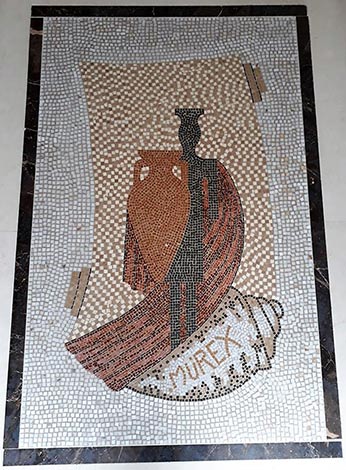
The artist executed a new mosaic work - 2018
Phoenician sculptures: Statuettes
Stone bas-relief Phoenician sculpture
Sculpted stone bas-relief stands with fossils
Sculpted stone bas-relief stands - First Catholic Holy Communion and Baptism
Birth of Rocks by Antoine El-Hachem
Stone sculpture Cedar of Lebanon
Artist sculptor Antoine El Hachem gave a trophée to artist painter and poet Joseph Matar